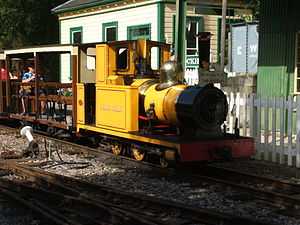Polar Bear (locomotive)
| Polar Bear | |
|---|---|
 Polar Bear at Amberley | |
| Specifications | |
| Power type | Steam |
| Designer | William Gordon Bagnall |
| Builder | W.G. Bagnall & Co., Stafford |
| Serial number | 1781 |
| Build date | 1905 |
| Configuration | 2-4-0 |
| Boiler pressure | 120 psi (0.83 MPa) |
| Cylinders | Two |
| Cylinder size | 4.5" bore x 7.5" stroke |
| Top speed | 15 mph (24 km/h) |
| Tractive effort | 1290lbs |
| Locomotive brake | Hand |
| Train brakes | Air |
| Career | |
| Railroad(s) | Groudle Glen Railway |
| Withdrawn | 1962 |
| Restored | 1979–1982 |
| Disposition | Preserved at Amberley Museum & Heritage Centre |
Polar Bear is a Bagnall steam locomotive built in 1905 for the Groudle Glen Railway, to supplement the similar but slightly smaller Sea Lion. The two Bagnalls were temporarily taken out of service in the 1920s when they were replaced by a pair of battery locomotives. These proved unsatisfactory, and Polar Bear and Sea Lion were returned to traffic. The railway was closed for the duration of World War II, and when the line reopened in the late 1940s only Polar Bear was returned to traffic. Following the 1962 closure of the GGR, Polar Bear was sold to the Brockham Museum Trust in 1967. In 1982 it passed, with the rest of the Brockham collection, to the Amberley Museum Railway, where it was returned to traffic in the early 1980s. Polar Bear's boiler was condemned around 1988, returning to service with a new boiler in 1993. It's boiler certificate expired at the end of 2010; with a retube and work on the firebox being required before a return to service. Since being based at Amberley, Polar Bear has returned to the Groudle Glen on three occasions (1993, 1996 and 2005) to visit.
Polar Bear was stripped down for overhaul in early 2011. The boiler was moved to Chatham for overhaul, with mechanical work being undertaken in-house at Amberley. The boiler was returned to Amberley in January 2012. Polar Bear was relaunched on 13th July 2013 by BBC newsreader and railway enthusiast Nicholas Owen, and is now in service sharing steam passenger duties at Amberley with the museum's 1917 Bagnall 0-4-0ST Peter.
Brown Bear
In January 2013 the Groudle Glen Railway announced a plan to construct a new locomotive to be named Brown Bear. Brown Bear will be built using the original Bagnall drawings for Sea Lion (Works No. 1484 of 1896) and Polar Bear (Works No. 1781 of 1905) which have largely survived. Once the locomotive is complete it will operate alongside its older sister Sea Lion allowing the railway to accurately represent period from 1905 through until the outbreak of the Second World War when these diminutive locomotives would have been in service together daily during the busy summer months.
Polar Bear was an updated and more powerful version of Sea Lion incorporating a number of modifications. Some of these such as the change from Baguley's modified valve gear to Bagnall Price gear can be put down to changes in key personnel at W.G Bagnall's but others such as the larger diameter cylinders, increased grate area and increased driving wheel diameter were probably specified in light of 9 years experience with Sea Lion in service. The most obvious visible difference between the two locomotives of course is the change from round to rectangular spectacle plates in the front cab sheet which improved the forward vision for the driver.
As Polar Bear was the last locomotive ordered by the original railway company and is arguably a more advanced design Brown Bear will be built as close as modern manufacturing techniques will allow to Polar Bear’s design. The original locomotives made extensive use of cast components and while the new build will use castings where patterns are already available some one-off components will be fabricated.
Working on the assumption that major components will be manufactured off site by a series of specialist firms before coming together for final assembly at Groudle the total cost of the build is expected to be in the region of £50,000.00 with completion expected within 5 years
Further information about the project together with how you can support the build can be found by visiting www.ggr.org.uk